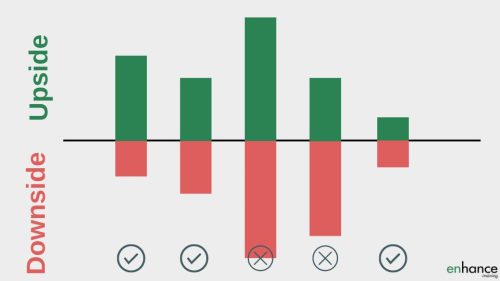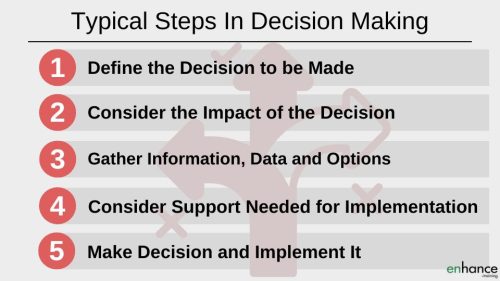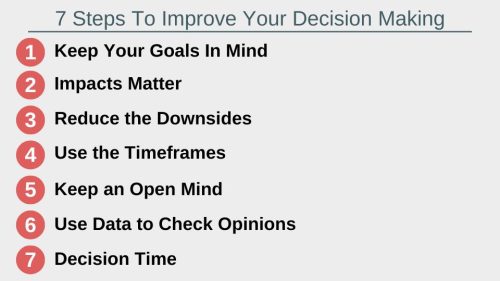7 steps to improve your decision making

To improve your decision making, I am sharing different methods to create the time and space to focus on the important decisions and reduce the time and energy spent on the less important decisions.
We all make decisions every single day and we have been doing so for years. We live in an age of choice. Every day you are faced with so many decisions to make, if you give equal time and energy to each you quickly become overloaded and end up making no decisions or poor decisions.
In business, as your career progresses, the decisions you need to make increase in range and impact. Improving your decision making at work is more than just a sensible step – it can be career defining.
7 steps to improve your decision making
- Keep your goals in mind
- Impacts matter
- Reduce the downsides
- Use the timeframes
- Keep an open mind
- Use data to check opinions
- Decision time
Watch on YouTube
Listen on Podcast
Keep your goals in mind : 1 of 7 steps to improve your decision making
Being clear on your goals is huge in making decisions more easily and quickly. In a business setting, if your goal is to hit a sales target, making the decision to pick up the phone another 5 times aligns with hitting your sales target. Taking a day off when you are just short of hitting your target goes against reaching your goal.
Try to keep the decisions you need make at work aligned to your personal, team and business goals where it makes sense. Aligning decisions with goals saves you time and energy in decision making.
Aligning decisions with goals works just as well in your personal life too.
Another area to use as a reference to improve your decision making is your values and behaviours. Your values rarely change quickly, therefore using them as reference points in your decision making keeps your decisions more consistent. This is very useful when managing team as consistency of decision making is a critical behaviour to adopt if you want to reduce the people problems you have to deal with in the team.
Impacts Matter in Decision making Processes
If you are spending the same amount of time thinking about all your decisions, stop right now. You are wasting a lot of your time and energy needlessly. All the decisions you have to make all have vastly different impacts.
What coffee to buy in the morning has no real impact. What career you pursue, who you marry, where you live – these are all decisions with large or huge long term impacts on your life.
Start grouping your decisions by the impact each decision has on you, your team or business. For decisions with no real impact, make the decision very quickly – go with your gut, your whim whatever way works for you. Spend as little time and energy on the decision making process as possible.
Low Impact
For the decisions that are low impact, spend a bit more time considering the options or outsource the decision making process to a suitably skilled team member to get to a recommendation. The aim is to minimise the time and energy you spend on these decisions so you create time to focus on the larger impact decisions.
High Impact
For decisions with large impacts, use time and energy to go through the options you have available, considering the upsides and downsides, critical failure points, alignment with goals, how practical the decision would be to implement and the other factors we are covering to guide your decision.
You should also consider if the impact of the decision is reversable or how easy or quickly you can change or reverse course if the decision you make doesn’t give you the result you expect or need. The easier it is to recover or change from a decision, the less energy or time you need to spend analysing the options.
Think through who, what and how your decision will impact others before making it.

Reduce the Downsides : 3 of 7 steps to improve your decision making
Removing the options with the largest downsides is a good way to cut down the time spent considering different options. Decisions with large downsides are much harder to get signed off and to build the support needed to implement them within a business.
Another route is to decide what is the worse case outcome you are happy to live with and remove any options from consideration which have downsides bigger than the worst case you are happy with.
Limiting the decisions with large downsides is an effective part of the process to improve your decision making at work.

The fourth of 7 steps to improve your decision making is Use the timeframes
Every decision has some kind of timeframe attached. At work, if you don’t make a decision in the timeframes needed, you let someone down, or you miss the opportunity or your problems increase.
When you have identified the important decisions, what you don’t want to do is put off making a decision until the last minute. Start work as soon as you can to gather options, consider the impacts, the pros and cons, the resources needed etc. Don’t start this at the last minute because you are more likely miss something vital and make a decision you later regret.
Rushing important decisions or decisions that have complex impacts reduces the chances of making a good decision.
On the flip side, for decisions with little or no impact, don’t procrastinate or put them off. Make a quick decision or outsource them and get them off your list of to do’s. This clears your mental space for the decisions with a lot more impact.
Keep an open mind : Step 5
We go into most decisions with a preference based on our experience, our emotions, and our assumptions. Being aware of our preferences and why we have those preferences is critical to making good decisions.
I have literally lost count the number of times that I started the decision making process with a preference and after going through the data and the opinions of others realised that there was a better solution or a better decision to take. Don’t allow yourself to become too emotionally invested in a course of action or a decision that blinds you to better options.
Also try not to make a decision and then go looking for the evidence or logic to back up your decision – what is called confirmation bias. We all do this to some extent. Counter it by asking the what if questions and looking for the problems too. Spotting problems with decisions or the implementation of those decisions while on paper is so much better, easier and less embarrassing, than after the implementation has been started.
Keep an open mind and don’t be afraid to change direction towards a better decision.
Use data to check opinions : 6 of 7 steps to improve your decision making
Everyone has an opinion and many of them at work are influenced by agendas, emotions, experiences and assumptions that you are not aware of. Using others or your team members to help with important decisions can be extremely useful – you get different viewpoints, different challenges, different thinking – all of which can help unearth better options and better decisions, particularly for difficult or complex decisions with big impacts.
I have found it extremely useful to check the data available against opinions and recommendations to make sure the opinions and recommendations fit what the data is saying. This acts as a check to reduce bias in other people’s opinions and reduce the wool being pulled over your eyes.
That being said, check how the data is put together, if it gives a complete enough picture of what is happening, and if data is inaccurate or misleading. If opinions and data are very different, dig into more detail to find out which you should give more weight to.
Don’t get caught up with data paralysis. You need enough data to help you make a decision rather than every bit of data available. This is ultimately a judgement call. Everyone in business needs to make decisions with an incomplete data regularly. You need enough not everything.
Lastly, avoid trying to make the perfect decision. Usually you are balancing between bad options or okay options. Rarely is their a standout option that screams pick me. If you find this, the decision is a lot easier. Good enough decisions are what you should aim for as a general rule. The higher the impact, the better the decision you should aim to make.
The seventh step to improve your decision making is Making A Decision
Making no decision is often the worst of all the options. Delays and indecisiveness lead to a lot of frustration and lost opportunities. Making a poor decision is often better than making no decision.
Make your decision or accept the recommendation or ask others to help in the decision making process. Whichever route you take you need to get to the best decision you can before your timeframe runs out.
Most decision making processes in business include these steps or methods:

Use the steps I have outlined to categorise the decisions you are faced with, so you have more time and energy for the important ones. Then use these 5 methods to improve your decision making to get the best decision you are able to.
Make your decision and then ensure that your decision will be implemented or put into action. A decision without action doesn’t achieve very much. Act on your decisions or ensure that others act of them on your behalf.
In summary
In summary, because we have so many decisions to make each day, we have gone through 7 steps to improve your decision making by reducing the time and energy spent on the decisions with little impact. This gives you more time and energy to focus on the decisions with larger impacts.
This approach improves the quality of your decision making for the decisions that count.

As a manager, your time spent making decisions is precious.
It is so easy to get swamped with decisions that are trivial. These should be made quickly or outsourced to other team members who have more time to properly consider them. This in turn helps them build their decision making skills and confidence.
Create as much time as possible to focus on the key decisions. This will make the decision making process easier and a lot more enjoyable.






